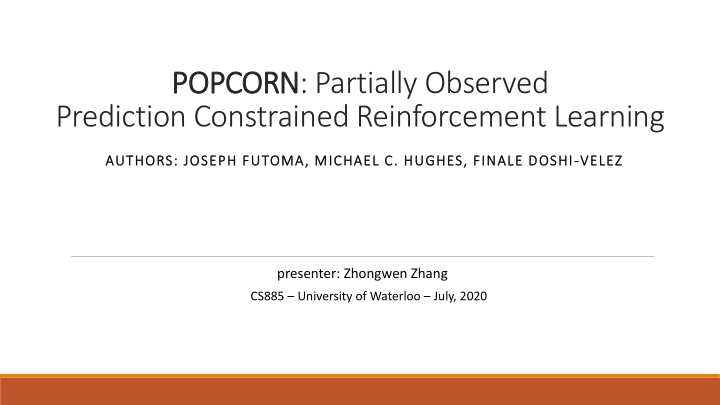



POPCORN: Partially Observed Prediction Constrained Reinforcement Learning AUTHORS: JOSEPH FUTOMA, MICHAEL C. HUGHES, FINALE DOSHI-VELEZ presenter: Zhongwen Zhang CS885 – University of Waterloo – July, 2020
Overview ◆ Problem: decision-making for managing patients in ICU (Intensive Care Unit) with acute hypotension ◆ Challenges: Solutions: ◦ Medical environment is partially observable POMDP ◦ Model misspecification POPCORN ◦ Data limited OPE (Off Policy Evaluation) ◦ Data missing Generative model ◆ Importance: more effective treatment is badly needed
Related work ◆ Model-free RL methods assuming full-observability [Komorowski et al., 2018] [Raghu et al., 2017] [Prasad et al., 2017] [Ernstet al., 2006] [Martín-Guerrero et al., 2009]. ◆ POMDP RL methods (two-stage fashion) [Hauskrecht and Fraser, 2000] [Li et al., 2018] [Oberst and Sontag, 2019] ◆ Decision-aware optimization: ◆ Mode-free [Karkus et al., 2017] 1. On-policy setting ◆ Model-based [Igl et al., 2018] 2. Features extracted from network
High-level Idea ◆ Find a balance between purely maximum likelihood estimation (generative model) and purely reward-driven (discriminative model) extreme.
Prediction-Constrained POMDPs ◆ Objective: ◆ Equivalently transformed objective: ◆ Optimization method: gradient descent
Log Marginal Likelihood ℒ 𝑓𝑜 ◆ Computation: EM algorithm for HMM [Rabiner, 1989] ◆ Parameter set: Estimated separately
Computing the value term 𝑊(𝜌 𝜄 ) ◆ Step1: Computing 𝜌 𝜄 by PBVI (Point-Based Value Iteration) ◆ Step2: Computing 𝑊(𝜌 𝜄 ) by OPE
Computing the value term 𝑊(𝜌 𝜄 ) ◆ Step1: Computing 𝜌 𝜄 by PBVI (Point-Based Value Iteration) [Joelle Pineau, et.al., 2003] ◆ Exact value iteration costs exponential time complexity ◆ Approximation by only computing the value for a set of belief points polynomial time complexity 𝑊 = {𝛽 0 , 𝛽 1 , 𝛽 2 , 𝛽 3 } 𝑐 0 𝑐 2 𝑐 3 𝑐 1
Computing the value term 𝑊(𝜌 𝜄 ) ◆ Step1: Computing 𝜌 𝜄 by PBVI (Point-Based Value Iteration) ◆ Step2: Computing 𝑊(𝜌 𝜄 ) by OPE ◆ 𝜌 𝜄 vs. 𝜌 𝑐𝑓ℎ𝑏𝑤𝑗𝑝𝑠 ◆ Importance sampling: ◆ Lower bias under some mild assumption ◆ Sample efficient
Empirical evaluation ◆ Simulated environments ◆ Synthetic domain ◆ Sepsis simulator ◆ Real data application: hypotension
Synthetic domain problem setting: ? ?
Synthetic domain finding relevant advantage of robust to signal dimension generative model misspecified model
Sepsis Simulator ◆ Medically-motivated environment with known ground truth ◆ Results:
Real Data Application: Hypotension
Real Data Application: Hypotension MAP: mean arterial pressure
Future directions ◆ Scaling to environments with more complex state structures ◆ Long-term temporal dependencies ◆ Investigating semi-supervised settings where not all sequences have rewards ◆ Ultimately become integrated into clinical decision support tools
References Komorowski, M., Celi, L.A., Badawi, O. et al. The Artificial Intelligence Clinician learns optimal treatment strategies for sepsis in intensive care. Nat Med 24, 1716 – 1720 (2018). https://doi.org/10.1038/s41591-018-0213-5 Raghu, Aniruddh, et al. "Continuous state-space models for optimal sepsis treatment-a deep reinforcement learning approach." arXiv preprint arXiv:1705.08422 (2017). Prasad, Niranjani, et al. "A reinforcement learning approach to weaning of mechanical ventilation in intensive care units." arXiv preprint arXiv:1704.06300 (2017). Ernst, Damien, et al. "Clinical data based optimal STI strategies for HIV: a reinforcement learning approach." Proceedings of the 45th IEEE Conference on Decision and Control . IEEE, 2006. Martín-Guerrero, José D., et al. "A reinforcement learning approach for individualizing erythropoietin dosages in hemodialysis patients." Expert Systems with Applications 36.6 (2009): 9737-9742. Hauskrecht, Milos, and Hamish Fraser. "Planning treatment of ischemic heart disease with partially observable Markov decision processes." Artificial Intelligence in Medicine 18.3 (2000): 221-244. Li, Luchen, Matthieu Komorowski, and Aldo A. Faisal. "The actor search tree critic (ASTC) for off-policy POMDP learning in medical decision making." arXiv preprint arXiv:1805.11548 (2018). Oberst, Michael, and David Sontag. "Counterfactual off-policy evaluation with gumbel-max structural causal models." arXiv preprint arXiv:1905.05824 (2019). Karkus, Peter, David Hsu, and Wee Sun Lee. "Qmdp-net: Deep learning for planning under partial observability." Advances in Neural Information Processing Systems . 2017. Igl, Maximilian, et al. "Deep variational reinforcement learning for POMDPs." arXiv preprint arXiv:1806.02426 (2018). Pineau, Joelle, Geoff Gordon, and Sebastian Thrun. "Point-based value iteration: An anytime algorithm for POMDPs." IJCAI . Vol. 3. 2003. Rabiner, Lawrence R. "A tutorial on hidden Markov models and selected applications in speech recognition." Proceedings of the IEEE 77.2 (1989): 257-286.
Recommend
More recommend